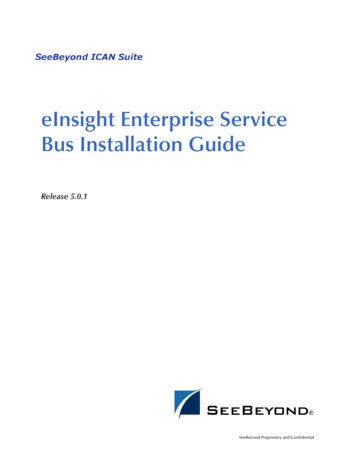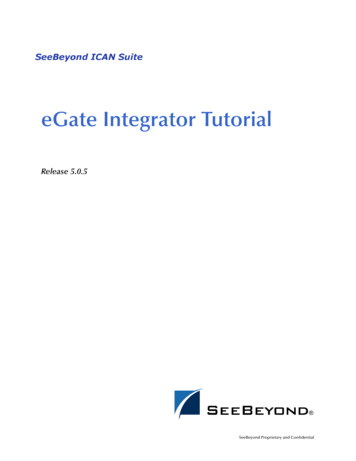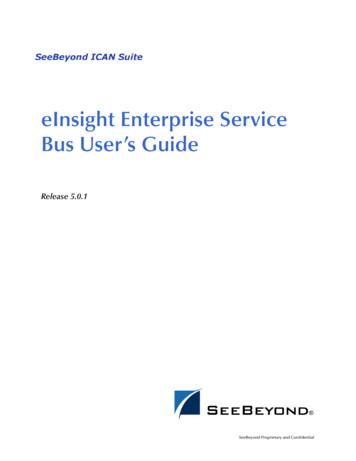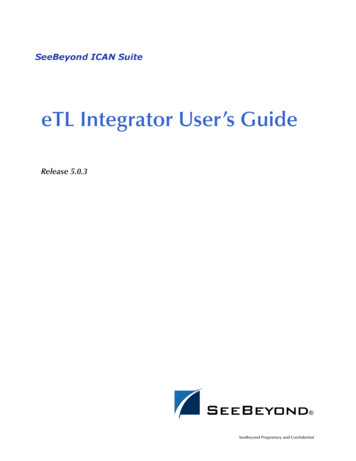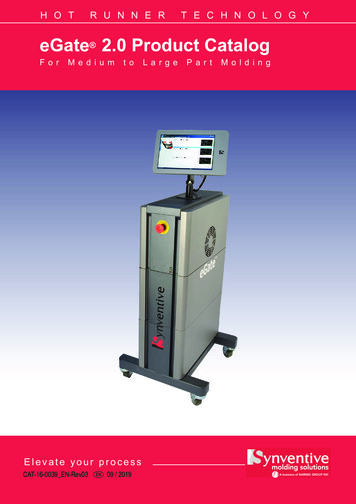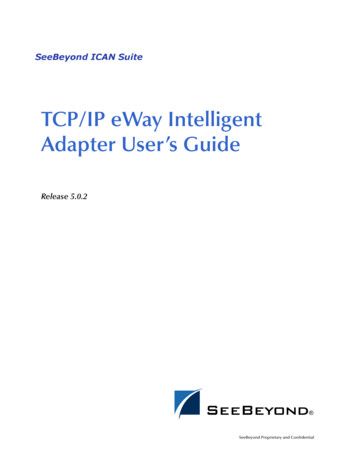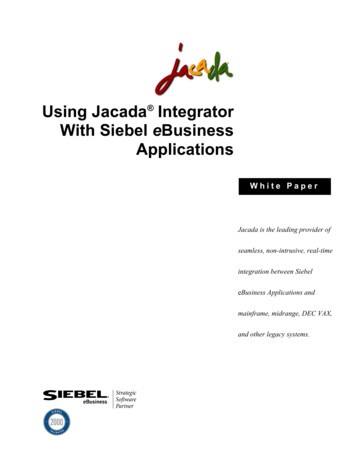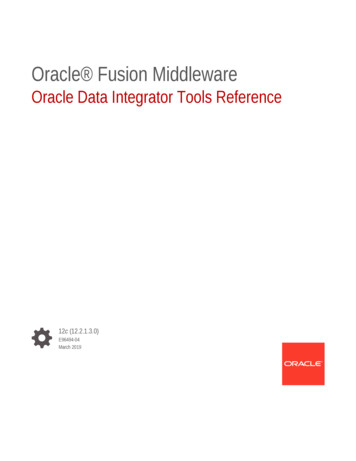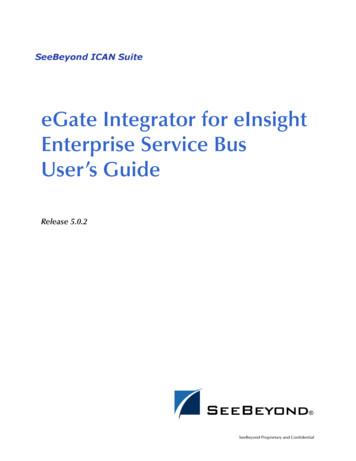
Transcription
eGate Integrator for eInsightEnterprise Service BusUser’s GuideRelease 5.0.2SeeBeyond Proprietary and Confidential
The information contained in this document is subject to change and is updated periodically to reflect changes to the applicablesoftware. Although every effort has been made to ensure the accuracy of this document, SeeBeyond Technology Corporation(SeeBeyond) assumes no responsibility for any errors that may appear herein. The software described in this document is furnishedunder a License Agreement and may be used or copied only in accordance with the terms of such License Agreement. Printing,copying, or reproducing this document in any fashion is prohibited except in accordance with the License Agreement. The contentsof this document are designated as being confidential and proprietary; are considered to be trade secrets of SeeBeyond; and may beused only in accordance with the License Agreement, as protected and enforceable by law. SeeBeyond assumes no responsibility forthe use or reliability of its software on platforms that are not supported by SeeBeyond.SeeBeyond, e*Gate, and e*Way are the registered trademarks of SeeBeyond Technology Corporation in the United States and selectforeign countries; the SeeBeyond logo, e*Insight, and e*Xchange are trademarks of SeeBeyond Technology Corporation. The absenceof a trademark from this list does not constitute a waiver of SeeBeyond Technology Corporation's intellectual property rightsconcerning that trademark. This document may contain references to other company, brand, and product names. These company,brand, and product names are used herein for identification purposes only and may be the trademarks of their respective owners. 2003 by SeeBeyond Technology Corporation. All Rights Reserved. This work is protected as an unpublished work under thecopyright laws.This work is confidential and proprietary information of SeeBeyond and must be maintained in strict confidence.Version 20031222150504.eGate Integrator for eInsight Enterprise Service BusUser’s Guide2SeeBeyond Proprietary and Confidential
ContentsContentsList of Figures8List of Tables12Chapter 1Introduction14Purpose and Scope14Intended Audience14Organization of Information15Writing Conventions16Additional Conventions16Supporting Documents16The SeeBeyond Web Site17Chapter 2System Overview18Introduction18Integration Model19System Architecture21RepositoryEnvironments2222User Interfaces23Enterprise DesignerEnterprise Manager2325Chapter 3Enterprise Manager26Overview26Installing and Updating eGateeGate Integrator for eInsight Enterprise Service BusUser’s Guide263SeeBeyond Proprietary and Confidential
ContentsMonitoring and Managing eGate26Starting Enterprise Manager27The Enterprise Manager Interface28HomeDocumentation2929The Enterprise Monitor30Chapter 4Enterprise Designer32Overview32Starting Enterprise Designer34Interface Features36MenusFile MenuTools MenuView MenuWindow MenuHelp MenuToolbarBrowser Buttons3636363737373839Enterprise Explorer40Project ExplorerEnvironment Explorer4041Enterprise Designer Editors42Connectivity Map EditorOTD EditorEnvironment EditorDeployment Editor43444546Additional Tools and Features47Project/Environment ImportImporting a Project Using Enterprise DesignerImporting a Project Using the Command LineProject/Environment ExportExporting a Project Using Enterprise DesignerExporting a Project Using the Command LineImpact AnalyzerVersion ControlChecking a Component InChecking a Component OutViewing a Component’s Version HistoryeGate Integrator for eInsight Enterprise Service BusUser’s Guide44747505151555658585960SeeBeyond Proprietary and Confidential
ContentsChapter 5eGate Projects61Overview61Project Components61The Project Explorer62Project Explorer IconsContext MenusRepository MenuProject MenuConnectivity Map Menu6364646566Using the Connectivity Map Editor67Services69Collaborations69Message Destinations70TopicsQueues7070External Applications71Schedulers71Component Connections73Configuring a Connection74Defining Constants and Variables76Chapter 6Web Services79Overview79SeeBeyond Web Services80UDDI Repository81Building a Web Client83Object Type DefinitioneInsight Business ProcesseGate Project848890Building a Web Server92eInsight Business ProcesseGate Project9696Chapter 7Object Type Definitions98OvervieweGate Integrator for eInsight Enterprise Service BusUser’s Guide985SeeBeyond Proprietary and Confidential
ContentsThe Bean-like InterfaceOTD TypesExternally-Defined OTDsBuilding OTDs98999999Using the OTD Wizard100Externally-Defined OTDs102Using the DTD WizardUsing the WSDL WizardWSDL OTD StructureWSDL Operation ElementsUsing the XSD Wizard102106109110111Using the OTD Editor115Node Management117Using the OTD Tester118Chapter 8Environments121Overview121Environment Explorer121Environment Explorer IconsContext MenusRepository MenuEnvironment MenuLogical Host Menu122123123124125Environment Editor127Defining Environmental Constants127Logical Hosts129OverviewInstalling the Logical Host as a Windows ServiceConfiguring a Logical HostConfiguring the Base Port NumberModifying the Logical Host Properties FileStarting a Logical HostStarting a Logical Host on a Windows SystemStarting a Logical Host on a UNIX SystemStarting a Logical Host on a Red Hat Linux SystemStopping a Logical HostIntegration Servers141Configuring an Integration ServerWeb ContainerPerformance Monitoring (Profiling)SecurityeInsight EngineApplication ManagerIntegration ServereGate Integrator for eInsight Enterprise Service BusUser’s 1461476SeeBeyond Proprietary and Confidential
ContentsMessage Servers149Chapter 9Project Deployment150Deployment Profiles150Using the Deployment Editor151Creating a Deployment Profile152Activating and Deactivating Deployment Profiles155Mapping Variables157Deploying Projects to Third-Party Servers158BEA WebLogicIBM WebSphere158161Glossary164e*Gate 4.x Terms in eGate 5.0170IndexeGate Integrator for eInsight Enterprise Service BusUser’s Guide1727SeeBeyond Proprietary and Confidential
List of FiguresList of FiguresFigure 1SeeBeyond ICAN Suite18Figure 2eGate Integrator19Figure 3eGate Integrator Implementation Model20Figure 4Typical eGate Integrator System21Figure 5Enterprise Designer23Figure 6Connectivity Map Editor24Figure 7SeeBeyond Enterprise Manager Login25Figure 8Enterprise Manager Login27Figure 9Enterprise Manager GUI28Figure 10Monitor Launch Window29Figure 11Documentation Tab29Figure 12Monitor Interface - Initial30Figure 13Monitor Interface - Environment30Figure 14SeeBeyond Enterprise Designer32Figure 15Login Dialog Box34Figure 16Enterprise Explorer: Project Explorer View40Figure 17Enterprise Explorer: Environment Explorer View41Figure 18Connectivity Map Editor43Figure 19OTD Editor44Figure 20Environment Editor45Figure 21Deployment Editor46Figure 22Import Manager Dialog Box (1)48Figure 23Open File Dialog Box48Figure 24Import Manager Dialog Box49Figure 25Import Status Message Box49Figure 26Export Manager Dialog Box (1a)51Figure 27Export Manager Dialog Box (1b)52Figure 28Export Manager Dialog Box (2)53Figure 29Save As Dialog Box53Figure 30Enter File Name Dialog Box (2)54Figure 31Export Status Message Box54Figure 32Impact Analyzer Dialog Box56eGate Integrator for eInsight Enterprise Service BusUser’s Guide8SeeBeyond Proprietary and Confidential
List of FiguresFigure 33Version Control - Check In Dialog Box58Figure 34Version Control - Check Out Dialog Box59Figure 35Version Control - History Dialog Box60Figure 36Project Explorer62Figure 37Repository Menu64Figure 38Project Menu65Figure 39Connectivity Map Menu66Figure 40Connectivity Map Window67Figure 41Linking JMS Topics67Figure 42Service Component69Figure 43External Application Drop-Down Menu71Figure 44Scheduler Properties Dialog Box72Figure 45Connection Icons in a Connectivity Map73Figure 46Default Configuration Dialog Box74Figure 47Project Variable Creation76Figure 48Project Constant Creation77Figure 49Variables and Constants Object Group77Figure 50Connector Properties78Figure 51SeeBeyond UDDI Repository81Figure 52Example Web Service WSDL File81Figure 53Microsoft Visual Studio Example82Figure 54File Destination Dialog Box83Figure 55Select WSDL Wizard84Figure 56Select File Location85Figure 57Select WSDL File86Figure 58Select External Server87Figure 59Web Client Business Process88Figure 60Web Client Business Process Receive Rule88Figure 61Web Client Business Process Write Rule88Figure 62Sample WSDL File89Figure 63Map Business Process90Figure 64Web Client Connectivity Map90Figure 65Web Client Example Project91Figure 66Project Deployment91Figure 67File Destination Dialog Box92Figure 68Select WSDL Wizard93Figure 69Select File Location94Figure 70Select WSDL File94eGate Integrator for eInsight Enterprise Service BusUser’s Guide9SeeBeyond Proprietary and Confidential
List of FiguresFigure 71Select External Client95Figure 72Web Server Business Process96Figure 73Connectivity Map96Figure 74Web Server Example Project96Figure 75Project Deployment97Figure 76OTD Wizard Selection Dialog100Figure 77OTD Wizard Selection: DTD Wizard102Figure 78Select DTD File(s) Dialog Box103Figure 79Select Document Elements Dialog Box104Figure 80Select OTD Options Dialog Box105Figure 81OTD Wizard Selection: WSDL Wizard106Figure 82WSDL Wizard: Select WSDL Location107Figure 83WSDL Wizard: Select WSDL File108Figure 84WSDL Wizard: Select OTD Options109Figure 85OTD Wizard Selection: XSD Wizard111Figure 86XSD Wizard: Select XSD File(s)112Figure 87Select Document Elements Dialog Box113Figure 88Select OTD Options Dialog Box114Figure 89OTD Editor115Figure 90OTD Tester118Figure 91Test Panel Data Display118Figure 92Select Data File119Figure 93Object Elements and Values119Figure 94Data Display: Refresh Icon120Figure 95Status Data Display120Figure 96Enterprise Explorer: Environment Explorer View121Figure 97Repository Menu123Figure 98Environment Menu124Figure 99Logical Host Menu125Figure 100 Environment Editor127Figure 101 Environmental Constants Panel128Figure 102 Logical Hosts129Figure 103 Startup Sequence130Figure 104 Install as Service Script131Figure 105 Windows Services List131Figure 106 Uninstall as Service Script132Figure 107 Logical Host Configuration Properties133Figure 108 Example logical-host.properties File135eGate Integrator for eInsight Enterprise Service BusUser’s Guide10SeeBeyond Proprietary and Confidential
List of FiguresFigure 109 Top-level IS Configuration Properties141Figure 110 Web Container Configuration Properties142Figure 111 Profiling Configuration Properties143Figure 112 Security Configuration Properties144Figure 113 eInsight Engine Configuration Properties145Figure 114 Application Manager Configuration Properties146Figure 115 Integration Server Configuration Properties147Figure 116 eGate Integrator Implementation Model150Figure 117 Deployment Editor Window151Figure 118 Example Deployment Profile (1)152Figure 119 Example Deployment Profile (2)153Figure 120 Example Deployment Profile (3)154Figure 121 Activate Dialog Box155Figure 122 Logical Host Context Menu - Apply155Figure 123 Activate Dialog Box156Figure 124 Deployment Profile Mappings157Figure 125 Project Variable Value Entry157Figure 126 WebLogic Deployment (1)159Figure 127 WebLogic Deployment (2)159Figure 128 WebLogic Deployment Verification160Figure 129 WebSphere Deployment (1)161Figure 130 WebSphere Deployment (2)162Figure 131 WebSphere Deployment Verification163eGate Integrator for eInsight Enterprise Service BusUser’s Guide11SeeBeyond Proprietary and Confidential
List of TablesList of TablesTable 1Writing Conventions16Table 2Enterprise Manager - Pages28Table 3Enterprise Manager - Control Tabs28Table 4Monitor Interface - Details Tabs30Table 5File Menu Options36Table 6Tools Menu Options36Table 7View Menu Options37Table 8Window Menu Options37Table 9Help Menu Options37Table 10Enterprise Designer Toolbar Icons38Table 11Browser Buttons39Table 12Impact Analyzer Command Buttons57Table 13Project Icons63Table 14Repository Menu Options64Table 15Project Menu Options65Table 16Connectivity Map Menu Options66Table 17Connectivity Map Toolbar Icons68Table 18Configuration Dialog Box Toolbar Buttons75Table 19OTD Wizard Navigation Buttons101Table 20OTD Editor Toolbar Icons116Table 21Environment Icons122Table 22Repository Menu Options123Table 23Environment Menu Options124Table 24Logical Host Menu Options125Table 25Environmental Constants Panel Icons128Table 26Logical Host Configuration Properties List133Table 27User-Modifiable Logical Host Properties137Table 28Startup Command Arguments138Table 29Top-level IS Configuration Properties List141Table 30Web Container Configuration Properties List142Table 31Profiling Configuration Properties List143Table 32Security Configuration Properties List144eGate Integrator for eInsight Enterprise Service BusUser’s Guide12SeeBeyond Proprietary and Confidential
List of TablesTable 33Application Manager Configuration Properties List146Table 34Integration Server Configuration Properties List147Table 35Deployment Toolbar Buttons151Table 36eGate 5.0 Terms170eGate Integrator for eInsight Enterprise Service BusUser’s Guide13SeeBeyond Proprietary and Confidential
Chapter 1IntroductionThis chapter describes the general purpose, scope, and organization of this document,and also provides references to additional sources of relevant information.1.1Purpose and ScopeThis User’s Guide provides general information about the features and operation ofSeeBeyond eGate Integrator in creating and deploying eGate Projects. For informationon eGate Integrator system management, see the eGate Integrator System AdministrationGuide.Note: Any operational explanations provided in this document are generic, for referencepurposes only, and do not necessarily address the specifics of setting up individualeGate Projects.1.2Intended AudienceThis User’s Guide is intended for personnel who are involved in integrating softwareapplications using eGate Integrator. To a large extent, these are individuals who will beusing the eGate Enterprise Designer to build eGate Projects to accomplish this task.This guide also provides a basic overview of the eGate product for those attempting togain a general understanding of how eGate Integrator works.This guide assumes that the reader is an experienced computer user, familiar withWindows-style GUI operations, and also has an in-depth understanding of theoperating system(s) on which eGate Integrator will be installed.Note: The eGate Integrator graphical user interface (GUI) runs only on Windows. Refer tothe eInsight Enterprise Service Bus Installation Guide for a list of operating systemson which eGate Integrator itself can run.eGate Integrator for eInsight Enterprise Service BusUser’s Guide14SeeBeyond Proprietary and Confidential
Chapter 1Introduction1.3Section 1.3Organization of InformationOrganization of InformationThis document provides information about eGate Integrator 5.0 and includes thefollowing chapters and appendices: Chapter 1 “Introduction” describes the purpose of this User’s Guide, includingwriting conventions and a list of related documents. Chapter 2 “System Overview” provides an overview of the general structure,architecture, and operation of eGate Integrator, and it’s place within the SeeBeyondICAN Suite. Chapter 3 “Enterprise Manager” provides a detailed overview of the EnterpriseManager, including its structure and operation. Chapter 4 “Enterprise Designer” provides a detailed overview of the EnterpriseDesigner, including its structure and operation. Chapter 5 “eGate Projects” explains how to create a Connectivity Map and use theConfiguration Editor to modify eWay and JMS connections between ConnectivityMap components. Chapter 6 “Web Services” describes how to use eGate Integrator in concert withother ICAN Suite components to create Web services. Chapter 7 “Object Type Definitions” describes how to create Object TypeDefinitions (OTDs). Chapter 8“Environments”explains how to create and populate eGateEnvironments, and how to configure and start Logical Hosts. Chapter 9 “Project Deployment” explains how to create and activate DeploymentProfiles. Appendix A“OTD Interfaces”describes the two types of OTD frameworks. Appendix B “The Schema Runtime Environment” describes the SRE Monitor,used to manage e*Gate 4.x schemas running within eGate 5.0.In addition, the Glossary on page 164 lists various terms used in this User’s Guide.eGate Integrator for eInsight Enterprise Service BusUser’s Guide15SeeBeyond Proprietary and Confidential
Chapter 1Introduction1.4Section 1.4Writing ConventionsWriting ConventionsThe following writing conventions are observed throughout this document.Table 1 Writing ConventionsTextConventionExampleButton, file, icon, parameter,variable, method, menu, andobject names.Bold text Command line argumentsand code samplesFixed font. Variablesare shown in bolditalic.bootstrap -p passwordHypertext linksBlue texthttp://www.seebeyond.comClick OK to save and close.From the File menu, select Exit.Select the logicalhost.exe file.Enter the timeout value.Use the getClassName()method. Configure the Inbound FileeWay.Additional ConventionsWindows SystemsFor the purposes of this guide, all references to Windows apply to MicrosoftWindows Server 2003, Windows XP, and Windows 2000.Path Name SeparatorThis guide uses a backslash (\) as the separator within path names. If you are workingon a UNIX system, please substitute a forward slash (/).1.5Supporting DocumentsThe following SeeBeyond documents provide additional information about the eGateIntegrator system as explained in this guide: eGate Integrator JMS Reference Guide eGate Integrator System Administration Guide eGate Integrator Tutorial eInsight Enterprise Service Bus Installation Guide SeeBeyond ICAN Suite Deployment Guide SeeBeyond ICAN Suite PrimereGate Integrator for eInsight Enterprise Service BusUser’s Guide16SeeBeyond Proprietary and Confidential
Chapter 1IntroductionSection 1.6The SeeBeyond Web SiteFor information on a specific add-on product (for example, an eWay IntelligentAdapter), see the User’s Guide for that product. A complete list of SeeBeyonddocumentation is included in the SeeBeyond ICAN Suite Primer.The documentation for the SeeBeyond ICAN Suite is distributed as a collection ofonline documents, which can be accessed through the Enterprise Manager (seeDocumentation on page 29 ). These documents are in Adobe Acrobat format, whichrequires that Acrobat Reader be installed on your computer. Acrobat Reader can befrom Adobe Systems as a free download from the following URL:http://www.adobe.com1.6The SeeBeyond Web SiteThe SeeBeyond Web site is your best source for up-to-the-minute product news andtechnical support information. The site’s URL is:http://www.seebeyond.comeGate Integrator for eInsight Enterprise Service BusUser’s Guide17SeeBeyond Proprietary and Confidential
Chapter 2System OverviewThis chapter provides an overview of the conceptual operation and general architectureof the eGate Integrator system.2.1IntroductionSeeBeyond’s Integrated Composite Application Network (ICAN) Suite providesbusinesses with a comprehensive, unified eBusiness infrastructure to connect,integrate, and manage enterprise-wide software applications running on variouscomputer systems. The full ICAN Suite is depicted in Figure 1.Figure 1 SeeBeyond ICAN SuiteSeeBeyond’s eGate Integrator provides the “backbone” for the ICAN suite, integratingthe various components of the Suite and all other connected components of thebusiness enterprise. As shown in Figure 2, eGate Integrator includes the EnterpriseManager and Enterprise Designer, which provide graphical user interfaces formanaging, configuring, and controlling the entire ICAN Suite and the businesseGate Integrator for eInsight Enterprise Service BusUser’s Guide18SeeBeyond Proprietary and Confidential
Chapter 2System OverviewSection 2.2Integration Modelprocesses running therein. See Enterprise Manager on page 25 and EnterpriseDesigner on page 23.Figure 2 eGate IntegratorOther major constituents of eGate Integrator shown in Figure 2 are the IntegrationServer, the JMS IQ Manager, and the Repository, all of which will be described brieflylater in this chapter. The flexibility of the eGate system allows the option of deploying itacross a distributed network of hardware platforms, if desired, and running it on anycombination of SeeBeyond, BEA WebLogic, and IBM WebSphere servers.eGate Integrator can communicate with and link multiple applications and databasesacross a variety of different operating systems. eGate performs with a wide variety ofhardware, message standards, operating systems, databases, and communicationprotocols in both real-time and batch (scheduled) integration modes.2.2Integration ModelSeeBeyond addresses application integration by means of an eGate Project, whichcontains the business logic required to solve the specific problem. The Project containsthe various logical components and supporting information required to perform therouting, processing, and caching of messages containing the relevant data from oneapplication to another. All Project information is stored in the Repository.Projects are created using tools contained within the Enterprise Designer and, oncedeployed, can be run and monitored using Enterprise Manager. Projects can also be setup to be run from the business process level using the SeeBeyond eInsight EnterpriseService Bus.Projects are run within Logical Hosts, which are individual, runtime instances of eGateIntegrator. Logical Hosts are defined within Environments, which represent thephysical resources required to implement the Project. Projects are mapped to theindividual Environments by means of Deployment Profiles, which are defined withineGate Integrator for eInsight Enterprise Service BusUser’s Guide19SeeBeyond Proprietary and Confidential
Chapter 2System OverviewSection 2.2Integration Modelthe Enterprise Designer and become part of the Project. Activating the DeploymentProfile deploys the Project to the associated Environment.This structure of Projects, Environments, and Deployment Profiles isolates eachimplementation into logical and physical components. This provides you withextensive flexibility and efficiency in designing eGate Integrator implementations. Forexample, once you build your Projects and Environments, you have the flexibility tochange each component without having to make changes to the other component.The finished Project, of course, will run in your production Environment; separateEnvironments, having the same structure as the production Environment, should becreated for development and testing. You may also want some additionalEnvironments, such as staging. The following figure illustrates the eGate Integratorimplementation model using a healthcare-related example.Figure 3 eGate Integrator Implementation ModelProjectsDeployment ProfilesEnvironmentsInsurance BillingDevelopmentDevelopmentPatient RecordsTestingTestingPatient AdmittanceStagingStagingProductionProductionEach Project defines a businessprocess.The deployment profiles map abusiness process to the systemsenvironment where the processwill be running.Each Environment defines aphysical environment whereProjects can run.In the figure above, any of the Projects can be deployed to any of the Environments viathe mapping defined in the deployment profiles. The example in the figure aboveshows that the patient admittance Project is already in the production phase andtherefore was deployed using the production deployment profile. The patient recordsProject is in the staging phase and was therefore deployed to the staging Environmentusing the staging deployment profile. The insurance billing Project is still beingdeveloped and tested, and therefore it is deployed to development and testing via thedevelopment and testing profiles.In broad outline, an eGate Integrator implementation includes the following steps:1 Design your Project.2 Define your Environments.3 Create your Deployment Profiles.4 Deploy the eGate Project.These implementation steps are all accomplished using the eGate Enterprise Designer,which is introduced in Enterprise Designer on page 23 and developed further insubsequent chapters.eGate Integrator for eInsight Enterprise Service BusUser’s Guide20SeeBeyond Proprietary and Confidential
Chapter 2System Overview2.3Section 2.3System ArchitectureSystem ArchitectureSeeBeyond’s eGate Integrator employs a versatile architecture that is ideally suited todistributed computing environments. As a result, the various components of an eGateIntegrator system can reside on the same hardware platform (assuming adequatesystem resources), or be distributed across several different hardware platforms in theenterprise network. Figure 4 shows an example system implementation that is highlydistributed.Figure 4 Typical eGate Integrator rverJMXHTTP/HTTPSDevelopment EnvironmentServerTest#3EnvironmentLogicalServer #5 EnvironmentHost #1ProductionLogicalHost #3 ServerServer #4LogicalHostLogicalServer #6Host #2LogicalHost #4 ServerLogicalHosteGate Integrator for eInsight Enterprise Service BusUser’s Guide21SeeBeyond Proprietary and Confidential
Chapter 2System Overview2.3.1Section 2.3System ArchitectureRepositoryThe setup, components, and configuration information for the elements of a Project arestored in the Repository. The Repository also stores all of the product binary files thatare required at runtime by the Logical Hosts. The components and configurations aredownloaded to the Logical Host during the initial bootstrap process and as neededafter design-time configuration changes are made.As shown in Figure 4, a single Repository serves the entire enterprise. This commonRepository is used for development, testing, and production purposes. Communicationbetween the Repository and other eGate components can be configured to use eitherHTTP or HTTPS. The Enterprise Designer and Enterprise Manager clients cancommunicate with the Repository and Enterprise Manager servers through a firewall.2.3.2EnvironmentsAn eGate Environment represents the physical system required to implement a Project.It consists of a collection of Logical Hosts, capable of hosting components of the ICANSuite, along with information about external systems involved in the implementation. Logical HostsEach Environment contains one or more Logical Hosts. A Logical Host contains oneor more integration servers, which are the engines that run eGate Collaborationsand eWays, and one or more message servers such as the SeeBeyond JMS IQManager, which manage JMS topics (publish-and-subscribe messaging) and queues(point-to-point messaging). External SystemsAn external system is a representation of a real, physical system that exists withinthe specific Environment, with configuration properties for locating and accessingthat system.In the example system shown in Figure 4, the production environment is split acrosstwo hardware platforms, each running a single Logical Host. Separate environmentsfor development and testing should duplicate the structure of the productionenvironment. The test environment should be supported by hardware similar to thatsupporting the production environment, to allow performance and load testing to giverepresentative throughput results. The hardware supporting the developmentenvironment, however, does not usually have the same performance requirements asthat supporting the test and production environments.An eGate Project is created within the development environment, then migrated to thetest environment, and finally to the production environment. This migration path is anecessary and highly critical practice in implementing a working system.Note again that there is no requirement for the components shown in Figure 4 to run onseparate systems; all could run on a single system, provided that resources (CPU,memory, and disk) are sufficient to support the concurrent usage.eGate Integrator for eInsight Enterprise Service BusUser’s Guide22SeeBeyond Proprietary and Confidential
Chapter 2System OverviewSection 2.4User Interfaces2.4User Interfaces2.4.1Enterprise DesignerThe Enterprise Designer graphical user interface (GUI) is used to create and configurethe logical components and physical resources of an eGate Project. Through this GUI(see Figure 5), you can develop Projects to process and route data through an eGateIntegrator system.Figure 5 Enterprise DesignerThe major features of the Enterprise Designer are the Enterprise Explorer on the left,and an editor panel on the right—which is initially blank. The Enterprise Explorerfollows the familiar Windows Explorer format, displaying a tree structure. The editorpanel displays a variety of editors, depending upon what component is selected in theEnterprise Explorer. The Connectivity Map Editor (see Figure 6) provides a graphicexample of one of these, in which logical components of a Project are created andconnected.eGate Integrator for eInsight Enterprise Service BusUser’s Guide23SeeBeyond Proprietary and Confidential
Chapter 2System OverviewSection 2.4User InterfacesFigure 6 Connectivity Map EditorThe features and usage of the Connectivity Map Editor are described in eGate Projectson page 61. Other editors are displayed for creating and modifying Object TypeDefinitions, Collaboration Definitions, Deployment Profiles, and other Projectcomponents.The Enterprise Designer also includes the design-time functionality for other ICANproducts, such as eInsight and eXchange. For more information on using other ICANproducts in the Enterprise Designer, see the product documen
Enterprise Service Bus User's Guide Release 5.0.2. eGate Integrator for eInsight Enterprise Service Bus . IBM WebSphere 161 Glossary 164 e*Gate 4.x Terms in eGate 5.0 170 Index 172. List of Figures eGate Integrator for eInsight Enterprise Service Bus User's Guide 8 SeeBeyond Proprietary and Confidential
